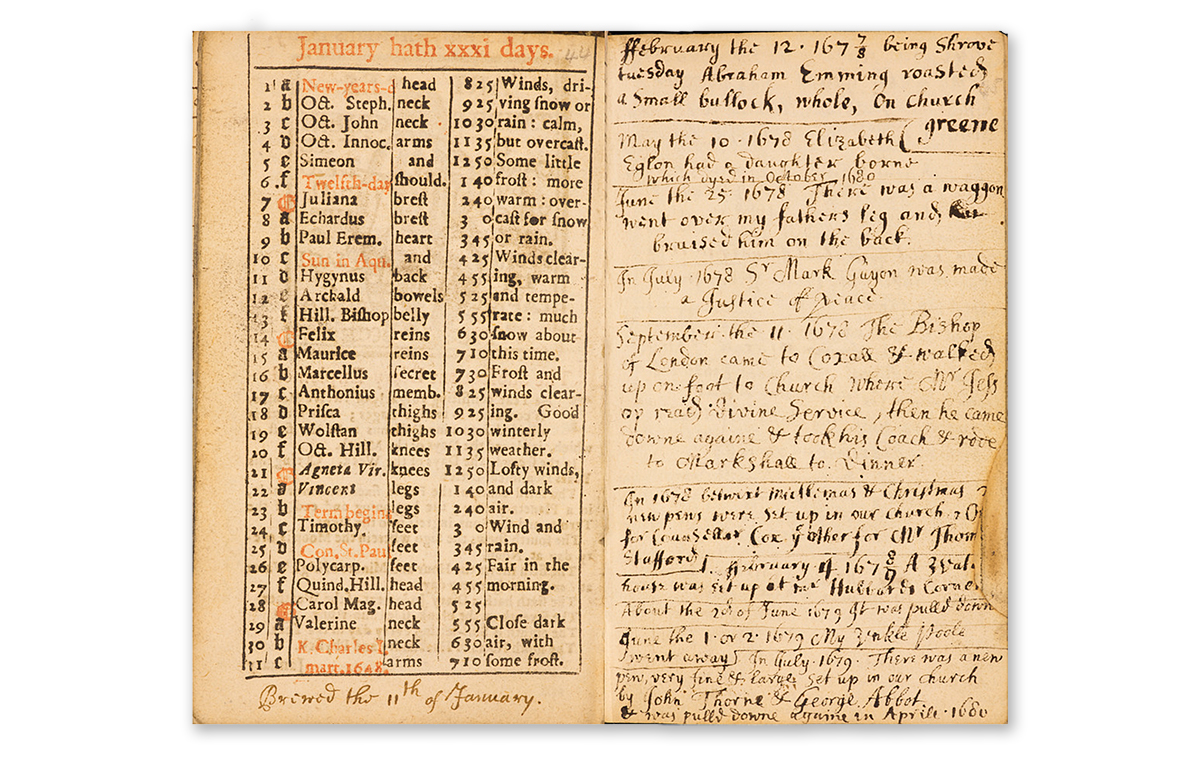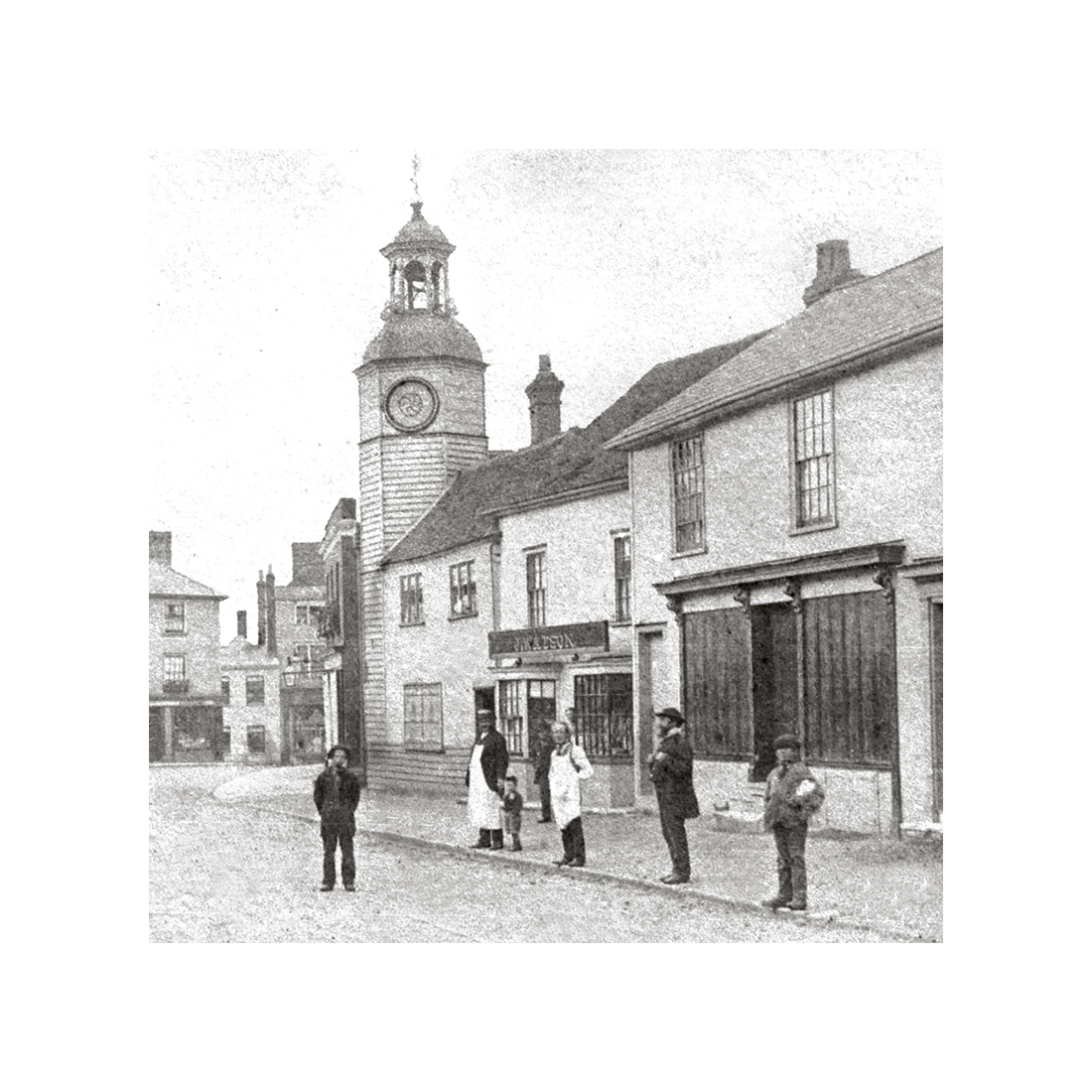JOSEPH BUFTON

Joseph Bufton was born in 1650 the youngest son of John and Elizabeth Bufton and had three sisters and one brother. The family was wealthier than most being taxed for five hearths when the average was two. Although evidently intelligent and literate, his education seems to have been limited in its scope – he had no Latin for example – perhaps because Coggeshall had no grammer school at that time. Joseph followed in his father’s footsteps and became a woolcomber, at one time it seems, running his own workshop.
Joseph never married and after the death of their parents his sister Rebekah kept house for the family until her marriage to Samuel Sparhauke in December 1699.

The diaries were written almost obsessively in the margins and on the blank pages of various published almanacs, some 22 in total, although only 11 are known to have survived.
Written between 1678 – 1715, they cover a range of topics, local events, deaths, marriages, celebrations, sermons, events in the wider world and the rules and statutes of his trade. From February 1678 to May 1697 he wrote a chronicle, covering two decades of Coggeshall’s history through about 180 entries of a line or two each.
The diaries are very unusual for their time both because of their content and as they were written by someone of the ‘middling sort’, someone without a university education.

It is from Bufton’s diaries that one learns of the custom of burying bodies at night accompanied by hooded torch-bearers, and of the body of a maiden being escorted by another young girl very like her in appearance and carrying a garland. They follow the trials of Widow Comon who was accused of witchcraft and thrown into the river to ascertain her guilt or innocence, the triumph of Squire Honywood in retaining his Parliamentary seat in 1692. His writings also cover national events – the fall of King James, the coming of William of Orange and his subsequent reign, the wars in Europe, the accessions of Queen Anne and George I – but all of these are interspersed with the happenings and comments on the lives and deaths of the people of Coggeshall, rich and poor all of whom are given equal significance and of whom he has a detailed knowlege of their family history.
He could be said to be man of more than ordinary ability and industry recording events that might otherwise be lost in the mists of time like fatal accidents, robberies, matters relating to trade and even murder. Bufton’s diaries give a wonderful insight into 17th and 18th century life in Coggeshall and extracts from them can be found in ‘The Annals of Coggeshall’ by the Rev. Bryan Dale and in ‘A History of Coggeshall’ by G. F. Beaumont.
It appears from a note in his diary that Joseph Bufton left Coggeshall on January 1st 1699, five years after the death of his father in 1694 at the ripe old age of 86. He moved to Hedingham – perhaps to stay with his sister’s family. He died there in 1718.
Extracts from Bufton’s Diary
1678, Feb. 12. Being Shrove Tuesday, Abram Emming roasted & small bullock whole on Church Green.
1679. Ab. Emming, comber, alehouse keeper, drummer, was buried soldier like. Moses Love, weaver, cryer, clerk of the market, was buried.
1680, Sep. 22. Mr. W. Gladwin being drunk, fell from his horse and died soon after.
1681, Feb. 1. There was a man, a stranger, whipt up Church Street at the cart’s tail.
1682, Dec. Ye widdow Mootone paid £15 because she had had a bastard. £10 of it was given to the poore.
1685, March 5. The poore that take collection had badges given them to weare, which was a P&O cut out in blew cloth.
1686, Nov.9. Mary Taylor, a low wench, was buried.
1688, March 1. There was a guard house set up for the soldiers at the market house.
There was a great fire at the kilne at Hovell’s, so that a man was forced to run through the fire to save himself, and burnt his face and hands.
1691, June 5. A maid, daughter of the widow Chilton, was buried, and a garland carried before her.
25. The widdow of Matt. Waters was buried. She had been drunk, and fell down stairs and died.
1692, Sep. 8, being Thursday, and the same day that Jacob Cox dyed, about 2 o’clock there was an earthquake at Coxall, and many towns beside hereabouts, and at London, and severall other countries we heard, and the news-letter said it was at the same time in Holland and ye rest of y’ provinces in ye Nether lands. I was in our garret at that time, and heard the house crack and perceived it shake, and was afraid it would fall, and therefore ran down staires.
1699, July 13. The widow Comon was put into the river to see if she would sink, because she was suspected to be a witch, and she did not sink, but swim. And she was tryed again July 19, and then she swam again, and did not sink.
July 24. The widow Comon was tryed a third time by putting her into the river, and she swam, and did not sink.
Dec. 27. The widow Comon, that was counted a witch, was buried.
1703, Nov. 26 and 27. There was an extraordinary great wind, which did more hurt by sea and land than ever was known to be done by one wind, by any person now living. Besides some persons were killed, many houses blown down or much damaged, many trees blown down, and many ships and seamen lost, which occasioned besides, a prayer read every Sunday for sometime, and a general fast to be kept on the 19th Feb. following.
The surviving diaries can be found in the Essex Record Office and in the Brotherton Collection of the University of Leeds.
To read more extracts from Bufton’s Diary click here
Three volumes of Joseph Bufton’s diary (the Brotherton Collection) have been scanned and can be viewed here; Bufton’s Diary